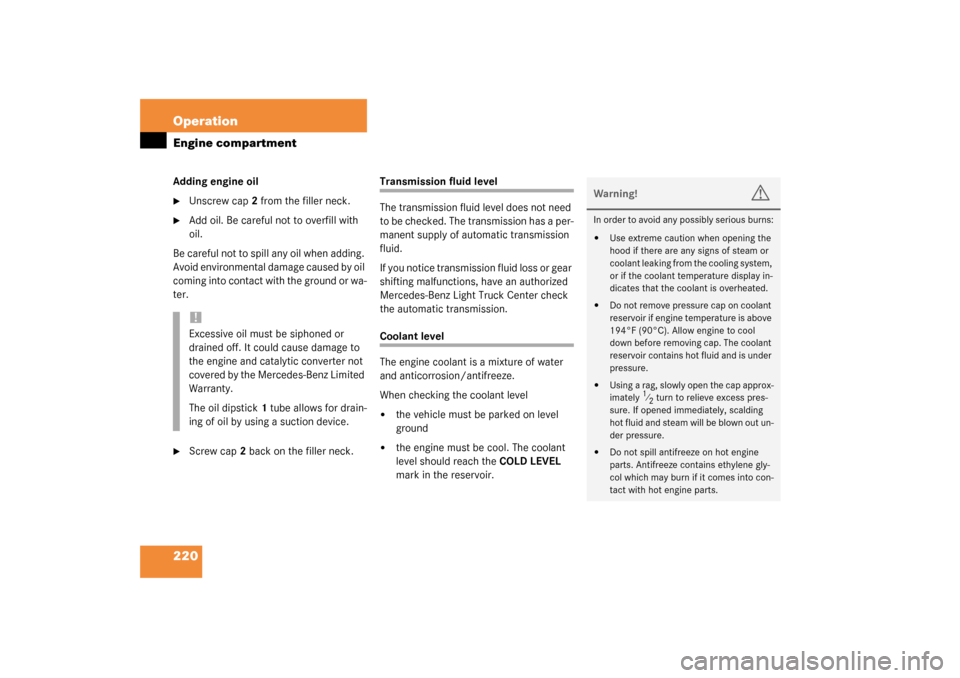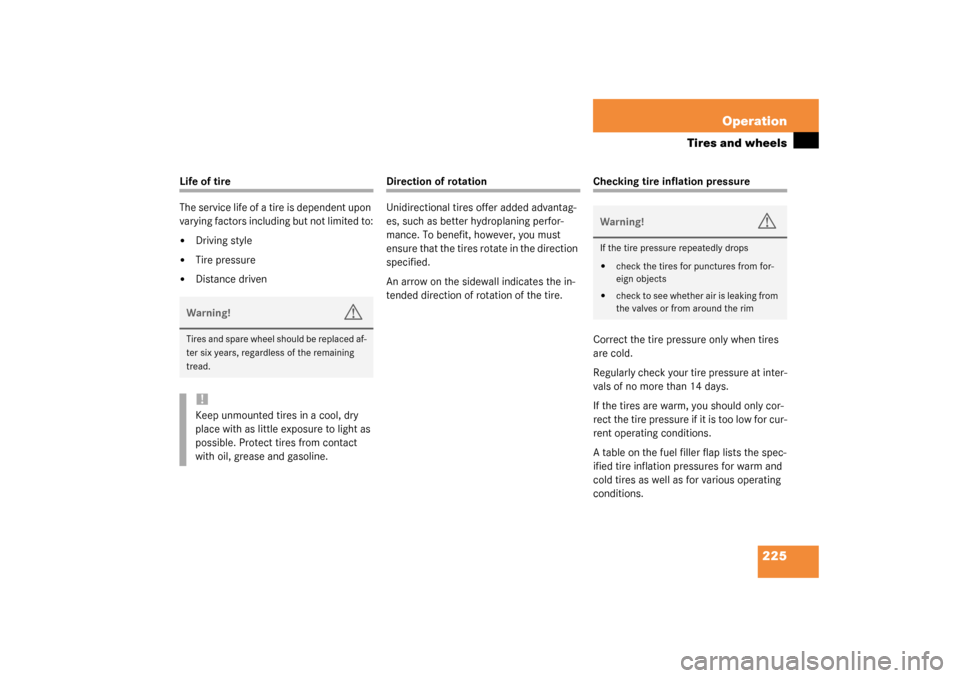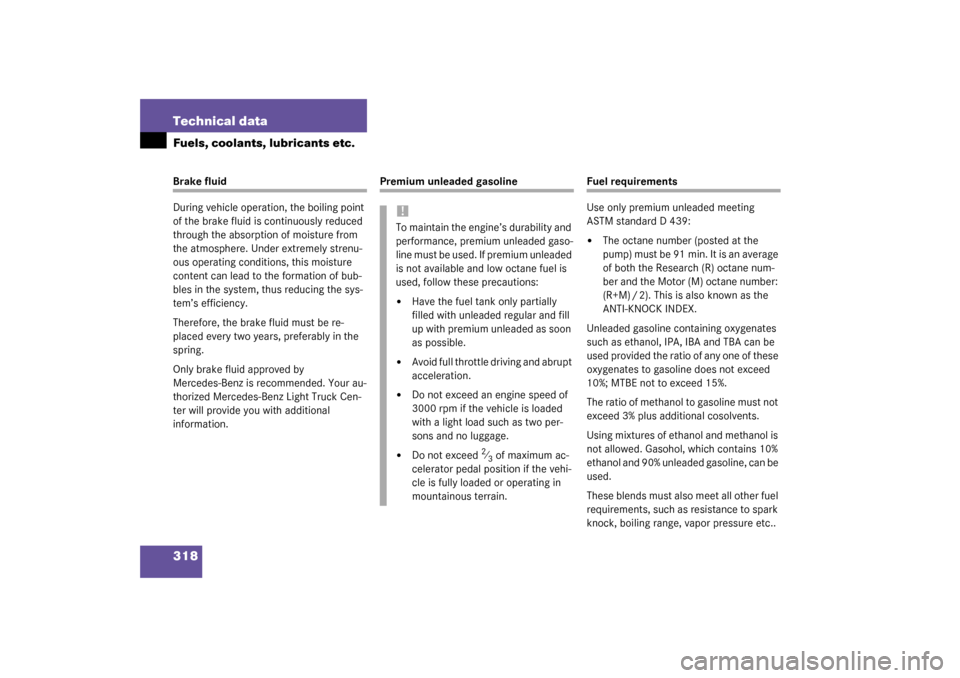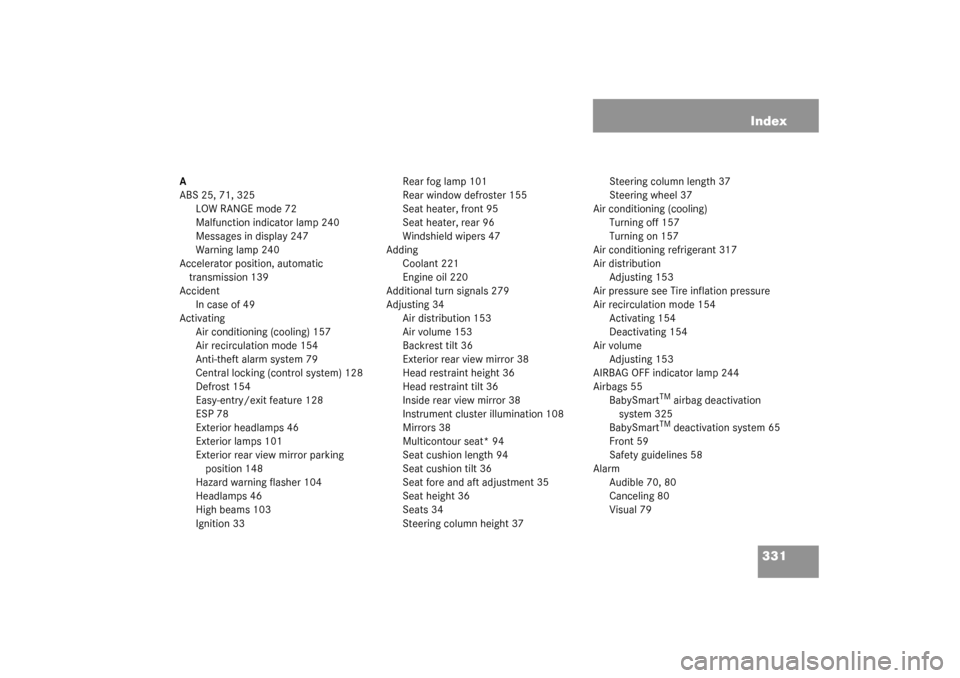Page 220 of 360

220 OperationEngine compartmentAdding engine oil�
Unscrew cap2 from the filler neck.
�
Add oil. Be careful not to overfill with
oil.
Be careful not to spill any oil when adding.
Avoid environmental damage caused by oil
coming into contact with the ground or wa-
ter.
�
Screw cap2 back on the filler neck.
Transmission fluid level
The transmission fluid level does not need
to be checked. The transmission has a per-
manent supply of automatic transmission
fluid.
If you notice transmission fluid loss or gear
shifting malfunctions, have an authorized
Mercedes-Benz Light Truck Center check
the automatic transmission.Coolant level
The engine coolant is a mixture of water
and anticorrosion/antifreeze.
When checking the coolant level �
the vehicle must be parked on level
ground
�
the engine must be cool. The coolant
level should reach the COLD LEVEL
mark in the reservoir.
!Excessive oil must be siphoned or
drained off. It could cause damage to
the engine and catalytic converter not
covered by the Mercedes-Benz Limited
Warranty.
The oil dipstick1 tube allows for drain-
ing of oil by using a suction device.
Warning!
G
In order to avoid any possibly serious burns:�
Use extreme caution when opening the
hood if there are any signs of steam or
coolant leaking from the cooling system,
or if the coolant temperature display in-
dicates that the coolant is overheated.
�
Do not remove pressure cap on coolant
reservoir if engine temperature is above
194°F (90°C). Allow engine to cool
down before removing cap. The coolant
reservoir contains hot fluid and is under
pressure.
�
Using a rag, slowly open the cap approx-
imately
1⁄2turn to relieve excess pres-
sure. If opened immediately, scalding
hot fluid and steam will be blown out un-
der pressure.
�
Do not spill antifreeze on hot engine
parts. Antifreeze contains ethylene gly-
col which may burn if it comes into con-
tact with hot engine parts.
Page 225 of 360

225 Operation
Tires and wheels
Life of tire
The service life of a tire is dependent upon
varying factors including but not limited to:�
Driving style
�
Tire pressure
�
Distance driven
Direction of rotation
Unidirectional tires offer added advantag-
es, such as better hydroplaning perfor-
mance. To benefit, however, you must
ensure that the tires rotate in the direction
specified.
An arrow on the sidewall indicates the in-
tended direction of rotation of the tire.
Checking tire inflation pressure
Correct the tire pressure only when tires
are cold.
Regularly check your tire pressure at inter-
vals of no more than 14 days.
If the tires are warm, you should only cor-
rect the tire pressure if it is too low for cur-
rent operating conditions.
A table on the fuel filler flap lists the spec-
ified tire inflation pressures for warm and
cold tires as well as for various operating
conditions.
Warning!
G
Tires and spare wheel should be replaced af-
ter six years, regardless of the remaining
tread.!Keep unmounted tires in a cool, dry
place with as little exposure to light as
possible. Protect tires from contact
with oil, grease and gasoline.
Warning!
G
If the tire pressure repeatedly drops�
check the tires for punctures from for-
eign objects
�
check to see whether air is leaking from
the valves or from around the rim
Page 318 of 360

318 Technical dataFuels, coolants, lubricants etc.Brake fluid
During vehicle operation, the boiling point
of the brake fluid is continuously reduced
through the absorption of moisture from
the atmosphere. Under extremely strenu-
ous operating conditions, this moisture
content can lead to the formation of bub-
bles in the system, thus reducing the sys-
tem’s efficiency.
Therefore, the brake fluid must be re-
placed every two years, preferably in the
spring.
Only brake fluid approved by
Mercedes-Benz is recommended. Your au-
thorized Mercedes-Benz Light Truck Cen-
ter will provide you with additional
information.
Premium unleaded gasoline
Fuel requirements
Use only premium unleaded meeting
ASTM standard D 439:�
The octane number (posted at the
pump) must be 91 min. It is an average
of both the Research (R) octane num-
ber and the Motor (M) octane number:
(R+M) / 2). This is also known as the
ANTI-KNOCK INDEX.
Unleaded gasoline containing oxygenates
such as ethanol, IPA, IBA and TBA can be
used provided the ratio of any one of these
oxygenates to gasoline does not exceed
10%; MTBE not to exceed 15%.
The ratio of methanol to gasoline must not
exceed 3% plus additional cosolvents.
Using mixtures of ethanol and methanol is
not allowed. Gasohol, which contains 10%
ethanol and 90% unleaded gasoline, can be
used.
These blends must also meet all other fuel
requirements, such as resistance to spark
knock, boiling range, vapor pressure etc..
!To maintain the engine’s durability and
performance, premium unleaded gaso-
line must be used. If premium unleaded
is not available and low octane fuel is
used, follow these precautions:�
Have the fuel tank only partially
filled with unleaded regular and fill
up with premium unleaded as soon
as possible.
�
Avoid full throttle driving and abrupt
acceleration.
�
Do not exceed an engine speed of
3000 rpm if the vehicle is loaded
with a light load such as two per-
sons and no luggage.
�
Do not exceed
2⁄3 of maximum ac-
celerator pedal position if the vehi-
cle is fully loaded or operating in
mountainous terrain.
Page 331 of 360

331 Index
A
ABS 25, 71, 325
LOW RANGE mode 72
Malfunction indicator lamp 240
Messages in display 247
Warning lamp 240
Accelerator position, automatic
transmission 139
Accident
In case of 49
Activating
Air conditioning (cooling) 157
Air recirculation mode 154
Anti-theft alarm system 79
Central locking (control system) 128
Defrost 154
Easy-entry/exit feature 128
ESP 78
Exterior headlamps 46
Exterior lamps 101
Exterior rear view mirror parking
position 148
Hazard warning flasher 104
Headlamps 46
High beams 103
Ignition 33Rear fog lamp 101
Rear window defroster 155
Seat heater, front 95
Seat heater, rear 96
Windshield wipers 47
Adding
Coolant 221
Engine oil 220
Additional turn signals 279
Adjusting 34
Air distribution 153
Air volume 153
Backrest tilt 36
Exterior rear view mirror 38
Head restraint height 36
Head restraint tilt 36
Inside rear view mirror 38
Instrument cluster illumination 108
Mirrors 38
Multicontour seat* 94
Seat cushion length 94
Seat cushion tilt 36
Seat fore and aft adjustment 35
Seat height 36
Seats 34
Steering column height 37Steering column length 37
Steering wheel 37
Air conditioning (cooling)
Turning off 157
Turning on 157
Air conditioning refrigerant 317
Air distribution
Adjusting 153
Air pressure see Tire inflation pressure
Air recirculation mode 154
Activating 154
Deactivating 154
Air volume
Adjusting 153
AIRBAG OFF indicator lamp 244
Airbags 55
BabySmart
TM airbag deactivation
system 325
BabySmartTM deactivation system 65
Front 59
Safety guidelines 58
Alarm
Audible 70, 80
Canceling 80
Visual 79